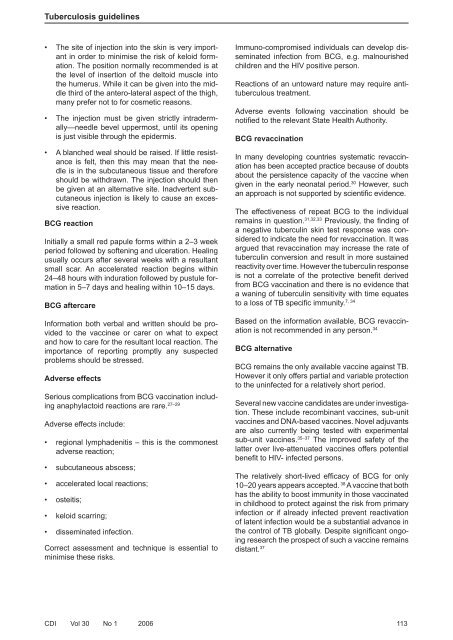PDF file - Department of Health and Ageing
PDF file - Department of Health and Ageing
PDF file - Department of Health and Ageing
Create successful ePaper yourself
Turn your PDF publications into a flip-book with our unique Google optimized e-Paper software.
Tuberculosis guidelines<br />
• The site <strong>of</strong> injection into the skin is very important<br />
in order to minimise the risk <strong>of</strong> keloid formation.<br />
The position normally recommended is at<br />
the level <strong>of</strong> insertion <strong>of</strong> the deltoid muscle into<br />
the humerus. While it can be given into the middle<br />
third <strong>of</strong> the antero-lateral aspect <strong>of</strong> the thigh,<br />
many prefer not to for cosmetic reasons.<br />
• The injection must be given strictly intradermally—needle<br />
bevel uppermost, until its opening<br />
is just visible through the epidermis.<br />
• A blanched weal should be raised. If little resistance<br />
is felt, then this may mean that the needle<br />
is in the subcutaneous tissue <strong>and</strong> therefore<br />
should be withdrawn. The injection should then<br />
be given at an alternative site. Inadvertent subcutaneous<br />
injection is likely to cause an excessive<br />
reaction.<br />
BCG reaction<br />
Initially a small red papule forms within a 2–3 week<br />
period followed by s<strong>of</strong>tening <strong>and</strong> ulceration. Healing<br />
usually occurs after several weeks with a resultant<br />
small scar. An accelerated reaction begins within<br />
24–48 hours with induration followed by pustule formation<br />
in 5–7 days <strong>and</strong> healing within 10–15 days.<br />
BCG aftercare<br />
Information both verbal <strong>and</strong> written should be provided<br />
to the vaccinee or carer on what to expect<br />
<strong>and</strong> how to care for the resultant local reaction. The<br />
importance <strong>of</strong> reporting promptly any suspected<br />
problems should be stressed.<br />
Adverse effects<br />
Serious complications from BCG vaccination including<br />
anaphylactoid reactions are rare. 27–29<br />
Adverse effects include:<br />
• regional lymphadenitis – this is the commonest<br />
adverse reaction;<br />
• subcutaneous abscess;<br />
• accelerated local reactions;<br />
• osteitis;<br />
• keloid scarring;<br />
• disseminated infection.<br />
Correct assessment <strong>and</strong> technique is essential to<br />
minimise these risks.<br />
Immuno-compromised individuals can develop disseminated<br />
infection from BCG, e.g. malnourished<br />
children <strong>and</strong> the HIV positive person.<br />
Reactions <strong>of</strong> an untoward nature may require antituberculous<br />
treatment.<br />
Adverse events following vaccination should be<br />
notifi ed to the relevant State <strong>Health</strong> Authority.<br />
BCG revaccination<br />
In many developing countries systematic revaccination<br />
has been accepted practice because <strong>of</strong> doubts<br />
about the persistence capacity <strong>of</strong> the vaccine when<br />
given in the early neonatal period. 30 However, such<br />
an approach is not supported by scientific evidence.<br />
The effectiveness <strong>of</strong> repeat BCG to the individual<br />
remains in question. 31,32,33 Previously, the fi nding <strong>of</strong><br />
a negative tuberculin skin test response was considered<br />
to indicate the need for revaccination. It was<br />
argued that revaccination may increase the rate <strong>of</strong><br />
tuberculin conversion <strong>and</strong> result in more sustained<br />
reactivity over time. However the tuberculin response<br />
is not a correlate <strong>of</strong> the protective benefi t derived<br />
from BCG vaccination <strong>and</strong> there is no evidence that<br />
a waning <strong>of</strong> tuberculin sensitivity with time equates<br />
7, 34<br />
to a loss <strong>of</strong> TB specifi c immunity.<br />
Based on the information available, BCG revaccination<br />
is not recommended in any person. 34<br />
BCG alternative<br />
BCG remains the only available vaccine against TB.<br />
However it only <strong>of</strong>fers partial <strong>and</strong> variable protection<br />
to the uninfected for a relatively short period.<br />
Several new vaccine c<strong>and</strong>idates are under investigation.<br />
These include recombinant vaccines, sub-unit<br />
vaccines <strong>and</strong> DNA-based vaccines. Novel adjuvants<br />
are also currently being tested with experimental<br />
sub-unit vaccines. 35–37 The improved safety <strong>of</strong> the<br />
latter over live-attenuated vaccines <strong>of</strong>fers potential<br />
benefi t to HIV- infected persons.<br />
The relatively short-lived effi cacy <strong>of</strong> BCG for only<br />
10–20 years appears accepted. 38 A vaccine that both<br />
has the ability to boost immunity in those vaccinated<br />
in childhood to protect against the risk from primary<br />
infection or if already infected prevent reactivation<br />
<strong>of</strong> latent infection would be a substantial advance in<br />
the control <strong>of</strong> TB globally. Despite signifi cant ongoing<br />
research the prospect <strong>of</strong> such a vaccine remains<br />
distant. 37<br />
CDI Vol 30 No 1 2006 113
















